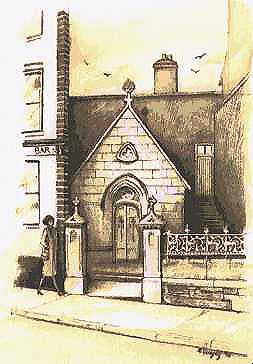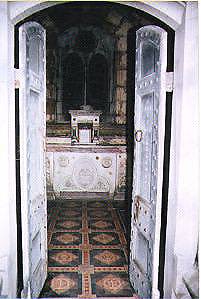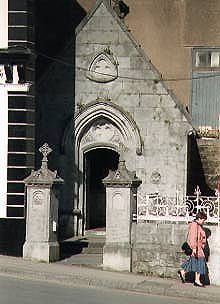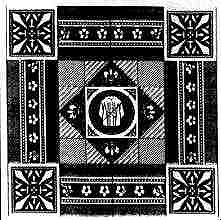
 A remarkable example of one man's deep love for his wife, this tiny R.C. chapel on Bridge Street in Carrick is the smallest in Ireland and reputedly the second smallest in the world. A remarkable example of one man's deep love for his wife, this tiny R.C. chapel on Bridge Street in Carrick is the smallest in Ireland and reputedly the second smallest in the world.
 When Mary Josephine Costello died at the age of 47 on 6th of October 1877 her heart-broken husband, Edward Costello, had her body embalmed and placed in the care of the Marist Sisters in Carrick-on-Shannon. He immediately commissioned, no expense spared, to have erected this beautiful Chapel in her memory and a last resting place for them both. When Mary Josephine Costello died at the age of 47 on 6th of October 1877 her heart-broken husband, Edward Costello, had her body embalmed and placed in the care of the Marist Sisters in Carrick-on-Shannon. He immediately commissioned, no expense spared, to have erected this beautiful Chapel in her memory and a last resting place for them both.
|  |
 |
 On April 22nd 1879 the Chapel was dedicated, solemn Requiem Mass was offered and Mary Josephine's remains were interred in a beautifully decorated coffin and placed in a sunken place to the left of the entrance and covered with a thick lid of specially made glass. A large gathering of clergy and laity attended this occasion. From that time until Edward Costello's death at the age of 68 on March 7 1891, Mass was celebrated on the First Friday of each month. When he died his remains were interred in the sunken space to the right of the entrance and a similar thick lid of specially made glass was placed over the coffin. On April 22nd 1879 the Chapel was dedicated, solemn Requiem Mass was offered and Mary Josephine's remains were interred in a beautifully decorated coffin and placed in a sunken place to the left of the entrance and covered with a thick lid of specially made glass. A large gathering of clergy and laity attended this occasion. From that time until Edward Costello's death at the age of 68 on March 7 1891, Mass was celebrated on the First Friday of each month. When he died his remains were interred in the sunken space to the right of the entrance and a similar thick lid of specially made glass was placed over the coffin.
|
 Born at Dromore, just a short distance from Carrick-on-Shannon, where he was a leading Merchant, Edward Costello was widely known as a man of great kindness and charity. Mary Josephine Costello was a native of County Longford. They had no family. The site of the Chapel is situated in what may be termed as the very heart of the town, tucked between two more recent buildings - Flynn's to the left and Armstrong's to the right and on the site of what was once a Methodist Chapel. Edward Costello purchased the site from the Methodist Trust. Born at Dromore, just a short distance from Carrick-on-Shannon, where he was a leading Merchant, Edward Costello was widely known as a man of great kindness and charity. Mary Josephine Costello was a native of County Longford. They had no family. The site of the Chapel is situated in what may be termed as the very heart of the town, tucked between two more recent buildings - Flynn's to the left and Armstrong's to the right and on the site of what was once a Methodist Chapel. Edward Costello purchased the site from the Methodist Trust.
|
 |
 |
 The Chapel itself is 16ft long 12ft wide and covers an area of 192 sq. ft. The entrance gate is placed between two handsome cut-stone pillars surmounted by tow Celtic crosses of exquisite design and tracery. The left pillar bears the inscription "1877 Costello Memorial Chapel", and extending from the right pillar is an ornamental railing set in a basement of cut-stone. The Chapel itself is 16ft long 12ft wide and covers an area of 192 sq. ft. The entrance gate is placed between two handsome cut-stone pillars surmounted by tow Celtic crosses of exquisite design and tracery. The left pillar bears the inscription "1877 Costello Memorial Chapel", and extending from the right pillar is an ornamental railing set in a basement of cut-stone.
 The exterior of the building is cut-stone surmounted by two Celtic crosses of the same material. There is but one entrance to the Chapel, a door of wrought galvanised iron. On the front gable in one of the component stones of the building is a raised monogram - the Costello coat of arms with the motto
"Ne te quaesiveris extra" - 'Seek not thyself outside thyself'. On the corresponding left side is a raised monogram with the letters E.M.C. beautifully entertained and the same motto again. The interior of the building is lined with Bathstone. There is no woodwork in the entire Chapel as the roof is an arched piece of masonry of the same material as the wall. Over the richly decorated marble altar is a stained glass window of handsome design. The exterior of the building is cut-stone surmounted by two Celtic crosses of the same material. There is but one entrance to the Chapel, a door of wrought galvanised iron. On the front gable in one of the component stones of the building is a raised monogram - the Costello coat of arms with the motto
"Ne te quaesiveris extra" - 'Seek not thyself outside thyself'. On the corresponding left side is a raised monogram with the letters E.M.C. beautifully entertained and the same motto again. The interior of the building is lined with Bathstone. There is no woodwork in the entire Chapel as the roof is an arched piece of masonry of the same material as the wall. Over the richly decorated marble altar is a stained glass window of handsome design.
|
 Decorated encaustic tiling with panels depicting scenes from the passion of Jesus separate the two glass covered vaults of husband and wife. The Costello chalice which was specially commissioned for the dedication ceremony of 1879 and subsequently used on the First Friday of each month was handed over to St. Mary's R.C. Church in Carrick-on-Shannon, after Edward Costello's death in 1891. Decorated encaustic tiling with panels depicting scenes from the passion of Jesus separate the two glass covered vaults of husband and wife. The Costello chalice which was specially commissioned for the dedication ceremony of 1879 and subsequently used on the First Friday of each month was handed over to St. Mary's R.C. Church in Carrick-on-Shannon, after Edward Costello's death in 1891. |
 |






